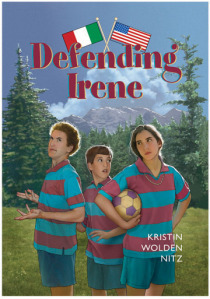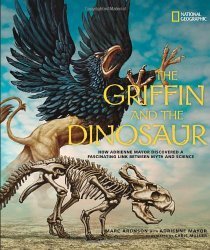Kristin Wolden Nitz's Blog, page 2
December 10, 2014
A Book for Girls Who Love Soccer
Do you have a fifth, sixth or seventh grade girl in your life who likes soccer? Well, here’s a spot of shameless self-promotion. I’m going to share a few reasons why you might consider getting a copy of DEFENDING IRENE as a Christmas present for a girl who loves to play soccer.
Let me start with a short summary:
 A thirteen-year-old American girl plays on a fiercely competitive boy’s soccer team during the year her family spends in Italy and experiences culture clashes both on and off the field.
A thirteen-year-old American girl plays on a fiercely competitive boy’s soccer team during the year her family spends in Italy and experiences culture clashes both on and off the field.A girl who plays soccer in Italy is regarded in much the same way as a girl who plays football in America. So Irene faces opposition from players, coaches, and even her Italian grandmother.
Here are some reviews:
What keeps this tale from being just another soccer story with play-by-play action is the unique setting; the inventiveness of the chapter headings, which consist of Italian words, pronunciations, and definitions; and Irene’s determination.” –School Library Journal
“Soccer fans, especially girls, will appreciate the well-drawn action sequences and Irene’s feisty spirit.” –Horn Book Guide
The March, 2008 of Library Sparks included this novel in their round-up of soccer picks as did School Library Journal in their Extra Helping series. It was also listed in Nancy Keane’s The Big Book of Teen Reading Lists in the Girls in Sports category for younger teens.
You typically won’t find this book at a bookstore–it was published a long time ago–so you’d probably have to order it by clicking on one of this link to Amazon. But if you think DEFENDING IRENE might interest a young soccer-playing friend, another very good option would be to check it out at your local library or talk to your children’s librarian about ordering a copy.

Paired Texts
My friend and fellow writer Stephanie Bearce wrote in her blog about how she’s a fan of pairing fiction and nonfiction in the classroom:
“It’s a great way to get students to try new genres of books. Those who believe nonfiction is “so boring” can learn just how exciting facts can be. And those children who don’t like “make believe stories” can learn how much research actually goes into writing a fiction book. Plus it makes for great discussion, stimulates student inquiry, and covers a multitude of common core requirements. It’s a win all around.”
She used the 2015 NSTA/CBC Best Science Tradebooks List. I was pleased and happy when she paired my Saving the Griffin with Marc Aronson’s The Griffin and the Dinosaur. In her blog, Stephanie highlights great nonfiction and gives suggestions for lesson plans that grew out of her time in the classroom.

October 21, 2014
Griffins and Dinosaurs
 My librarian friend Sondy Eklund wrote a review for THE GRIFFIN AND THE DINOSAUR. Looks fascinating!
My librarian friend Sondy Eklund wrote a review for THE GRIFFIN AND THE DINOSAUR. Looks fascinating!


October 15, 2014
Doing the YA Cha-Cha
I’ve been neglecting this blog. I think one of the reasons for this is that I’ve moved twice in the past two and a half years. But more than that, I’ve been busy doing the YA Cha-Cha. What’s that? Well, the astonishing Conrad Wesselhoeft, author of DIRT BIKES, DRONES AND OTHER WAYS TO FLY and ADIOS, NIRVANA explains that in a song that he wrote for Erin Murphy’s Dog when we were live in Vermont. It can feel like you’re going two steps forward and three steps back.


July 2, 2014
Blog Hop!
I’d like to thank Ann Finkelstein for asking me to participate in this blog hop. I’ve been neglecting my blog, and this gave me a reason to get back to it. Ann is a talented writer and photographer whose YA fantasy is now out on submission. You can read about her writing process here. I’m tagging Stephanie Bearce and Nancy Tupper Ling, two charming and witty writers.
– What are you currently working on?
Right now I’m working on a contemporary YA novel that’s a modern retelling of a classic.
– How does my work differ from others of its genre?
I’m not aware of any recent updates of this particular work. And if there are any adaptations out there, I doubt that they feature high school cross-country runners.
– Why do I write what I write?
This current project hit me over the head three days after my husband and I decided to move to Portland, Oregon. Scenes started unfolding in my head while I was out on a walk. Before I got home, I came up with any number of ways to deal the adjustments that I’d have to make to pursue the project and stay quite true to the source material. Otherwise, I tend to write the books that I like to read. My YA novel, SUSPECT, belongs to the cozy mystery genre. My contemporary fantasy, SAVING THE GRIFFIN , has been called a Narnia in Reverse by one reviewer, but one astute librarian recognized it as an appreciation for the works of Edward Eager. I always liked reading books about kids in unusual settings, so I knew that I had to pursue DEFENDING IRENE, about a girl playing soccer on a boys team in Italy.
Since I’ve also been a fan of historical fantasies, as exemplified by Megan Whalen Turner’s Attolia series and Lois McMaster Bujold’s Curse of Chalion , I’ve tried my hand at a couple of those. I’m also in the midst of working on one set in a place that has a number of things in common with Ancient Egypt a few generations after the invasion of Alexander the Great. But my Xander cemented his empire instead of having it fragment after his death. And then there are the magical elements…
–How does my individual writing process work?
I like writing the first draft of a scene by hand while using Natalie Goldberg’s strategy in her book called Writing Down the Bones. Here’s the short version. go into a coffee shop and “rent” a table through buying some kind of snack or beverage. That place is now my office, and I want to get my money’s worth. I pick up the pencil and start writing, keeping the hand moving at all times. Often, I get dialogue with just a sprinkling of action. Once I get home, I type everything into a computer and add a few more details. Then I keep working on the scene by layering on action and description. Once I bring that up to the level of a semi-polished rough draft, I head back to the coffee shop to start another scene. I usually have a general idea of where I’m headed, but I leave things open enough that I can follow inspiration. Sometimes I’ll jump ahead and write a key scene, but I usually work sequentially.
I tossed a lot of this process out the window for my current project. In two weeks, I went through the original work conversation by conversation and scene by scene and pulled together my take on what was going on with the modern characters. This took about two weeks. I’ve been building on this initial structure ever since. I’ve added some scenes of my own and taken some out of the original that just didn’t work in a modern context.
Stephanie Bearce’s Top Secret Files of History series will be coming out this fall, starting with Spies, Secret Missions, and Hidden Facts from World War II. I’m privileged to be in Stephanie’s critique group, so I’ve learned all sorts of cool things that have been hidden in history. This blog hop might wind up being one of her first blog posts on her new site. Stephanie will be posting on or around July 9th.
Nancy Tupper Ling is a talented children’s writer and poet. We met a few years ago at a retreat put on by our literary agency. I’m especially looking forward to one of her upcoming picture books. Here’s the official announcement: THE YIN-YANG SISTERS AND THE DRAGON FRIGHTFUL is a charming original fairy tale, told with heart and humor, about twin sisters Mai and Wei whose village has become encumbered by a very problematic dragon. Wei wants nothing more than to send that nasty old dragon packing. Mai… isn’t so sure. What are two sisters to do? Nancy will be posting on or around July 14th.
I’ll provide updates if needed.


March 2, 2013
Opening Up
I can’t speak for every novelist, but I have to say, as a person who has recently finished another draft of another first chapter, that I am willing to put my efforts at trying to find just the right word on a par with even the pickiest of picture book writers. Effort and effect are two different things naturally. I probably still don’t have everything where it needs to be, but I’m ready to move on.
Footnote
*And yes, I personally know writers at each end of the scale. In fact, Shutta Crum’s delightful MINE! uses the same word seven times. I’m actually not sure exactly how many words finally wound up in Jeanie Franz Ransom’s Land of Enchantment Book Award Winner WHAT REALLY HAPPENED TO HUMPTY? Maybe it wasn’t quite three thousand words, but it was ridiculously close to that in a time where most editors are looking for projects that are much, much short. The editors kept asking for more jokes and Jeanie kept delivering them.


February 9, 2013
When Lack of Sympathy is a Good Thing
Here’s an excerpt from Sue Bradford Edward’s recent blog post at Women on Writing:
For about two months, I’ve been playing around with a rewrite. I’ll work on it a bit and then set it aside because it hasn’t jelled. Every now and again, I figure out a problem and get some writing done, but after two months I have 10 pages. Ten. Can you say discouraged?
Fortunately, I had a critique group meeting last weekend. This was the perfect chance to trot out my problem manuscript. These writing friends would be able to point out a few more problems for me to fix, but they would also commiserate. Or so I thought.
They refused.
That’s right. Refused.
I confess to being a member of this critique group. What did we tell her?


January 27, 2013
The End
Many novelists I know have certain criteria for when they’re going to type “The End” at the bottom of a manuscript. I usually wait until that moment when I have a fairly continuous draft and a closing line. When I hit upon a potential last line for my Italian chase novel, I hesitated for a moment. I knew that this draft had a lot more holes and patches than my usual final drafts, but there was a reason for that. I just didn’t have time to sit around and figure out transitions from scene to scene if I was going to wrap up a draft of my novel in time for Christmas break for some of my busy beta readers. So whenever I got stuck, I used Leslie Connor’s wise advice of inserting the following marker: BRILLIANT TRANSITION GOES HERE. So then it’s not matter of admitting failure; instead, it’s more like making a promise.
I didn’t quite make my goal of finishing by Christmas despite foregoing certain aspects of holiday cheer and turning into a Writing Scrooge. (Happy New Year’s greetings will be heading out soon.) I did find an ending for my story a few days after Christmas, but I didn’t come up with a draft where I truly felt like I could write “The End” until January 10th. But I didn’t want my first round of beta readers to be left in a state of suspense about the eventual outcome.
So what now? Well, PORTRAIT is off to another group of readers. I’m in that waiting-for-feedback stage as I wait to see whether the vision in my head made it successfully onto the page. (Darcy Pattison shares a great discussion of this issue here.)


November 27, 2012
The Society of School Librarians International Best Books
I got the news that my young adult mystery SUSPECT was on the top of the Society of School Librarians International best books for language arts (grades 7-12) last fall, but the official link never popped up for me until last week. Now I’m honored to share it, especially since I’m in such good company.


November 24, 2012
Thinking About Soccer?
Some kids aren’t really sure whether or not they’d like to play a sport. If you know someone who’s thinking about trying soccer, strongly consider handing that person a copy of Ruth McNally Barshaw’s Ellie McDoodle: Most Valuable Player. This is the fourth book in Barshaw’s Ellie McDoodle series, a delightful collection of books for kids in third to sixth grade. Kirkus described the first book as ”Part journal, part graphic novel, all fun.”
While I’m recommending this book for kids who’re not sure if they’ll like soccer, the action will also satisfy kids who love the game.






